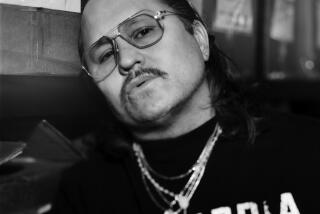Whitten Time : Fashion: For a long time Bill Whitten designed in obscurity while his rock music creations stole the spotlight, but no more.
Talking about the Grammys disturbs Bill Whitten.
Over the years he has designed more costumes for more Grammy winners than he can count. Michael Jackson’s beaded, spangled stage clothes are Whitten creations. So are Lionel Richie’s, Neil Diamond’s and even some of Elton John’s.
But, there is no Grammy award for the category of costume design. So, at tonight’s televised presentation, when more than 60 awards will be handed out--some for categories as esoteric as album notes--there won’t be a Grammy for the designer who put Michael Jackson in a single rhinestone glove.
“I’m just as much a part of the music industry as Michael Jackson,” Whitten said.
He was perched on a tall stool with his thin arms wrapped tightly around his chest. His matted tendrils of shoulder-length hair, brocade slippers and black tunic topped by a collar of black boa-feathers read like a rock fashion calling card.
The feathered collar covered his chest and each time he rocked back and forth in frustration, as he did any time the conversation tended toward Grammys, one or two would drift to the floor, adding to the feathered nest that encircled him.
Whitten’s name is rarely recognized outside the music business, yet his clothing designs are known the world over. With each moon-walking step and hand gesture, Michael Jackson displayed the Whitten style. The single glove and ankle-high black pants, and white socks with loafers were all designed for one purpose.
“It was very simple,” Whitten calmly explained. “The audience was missing his hand and feet movements. They couldn’t see the quick gestures he was making.”
Whitten dressed Elton John in extravagant capes and electric boots. He put Stevie Wonder in African print caftans and took Neil Diamond out of flower embroidered shirts and into bugle beads.
“When I came into the business the only man in a beaded jacket was Liberace. Nobody had tasty beading for men. Nobody.”
Neil Diamond was the first performer to find Whitten, back in 1974. Whitten had opened a custom shirt business called Workroom 27. The tiny shop was virtually invisible, located on the second floor of a building on Santa Monica Boulevard in West Hollywood. It was open for six months before the first customer walked through the door. Then Diamond showed up.
It wasn’t long before Diamond became an advocate of Whitten’s custom-designed clothes, and he spread the word. Doc Severinsen found his way to Workroom 27, and he brought the members of the band Chicago. Jim Brown came in and returned with Hugh Hefner. The domino effect took a year and a half to pay off. When it did, Whitten went from leasing one room to buying the entire building.
At the height of his rock ‘n’ roll rag business he had a factory that employed 50 people churning out the stage clothes for 20 groups--the Commodores, the Jacksons, Edgar Winter and Steppenwolf among others--as well as stars and regulars on the Redd Foxx and Richard Pryor television shows.
“They (lead singers) didn’t have one place they could go that could outfit them and the band. I was the one source for all that.”
Whitten’s business crested as more and more bands demanded a personalized stage style. Then he became selective and scaled his client list to include only top-rung performers. Today he regularly suits up Michael Jackson, Lionel Richie, his old friend Neil Diamond and others such as magicians Siegfried and Roy.
As he tried to down-scale his business, his popularity seemed to grow not only among performers but their wives and friends, and the fashion cognoscenti. Two of his most ardent clients are Brenda Richie, wife of Lionel, and Susan Fields, (of the Chicago retail empire, Marshall Fields).
Finally, he decided to give into the demand by opening a store on Melrose Avenue.
The store, called Bill Whitten, is scheduled to open March 4 and will carry everything from pajamas to evening wear for men and women. The broad range of apparel and accessories is priced at the high end of the spectrum. T-shirts start at $50 and some of the evening gowns top off at $20,000.
The clothes are not as outlandish as some of his stage costumes. The lines are clean and spare. They have to be, because the surface textures run riot. White silk suit jackets for men are beaded with bits of bone. Whitten sews metal sequins on 150-year-old, hand-loomed fabric from the Far East to make jackets. Evening dresses using a floral motif have beading that traces the print, adding three-dimensional pistils and stamens for the flowers.
Whitten’s most inventive decorations appear on tuxedos. Scrolls of embroidery decorate the shoulders and pocket flaps, and peek around the vents of tuxedo jackets. Other black wool tux jackets sport large shawl collars of matte black suede or slick black leather.
The clothes invite touching. From the sheer cotton voile pajamas and nubby chenille jackets to the fish skin boots that feel like leather, everything demands a tactile encounter, which is why the store is designed to look more like a gallery than a retail space. The expensive dresses will be kept in a glass vault.
The prices shriek Rodeo Drive. The workmanship on the garments is akin to European couture. And the exquisite beading and embroideries seem incongruous on the street known for its funky, forward clothes. But Whitten says the drums of the underground beat louder in West Los Angeles than they do in Beverly Hills.
“I have to create the underground trend first,” he says. “Those are the people I need to reach.” So he is starting on both coasts in the trendy pulse points, Melrose Avenue first and then, in early summer, in Manhattan’s SoHo District. If other cities want a Bill Whitten store, he’s only too happy to oblige. He intends to franchise them.






